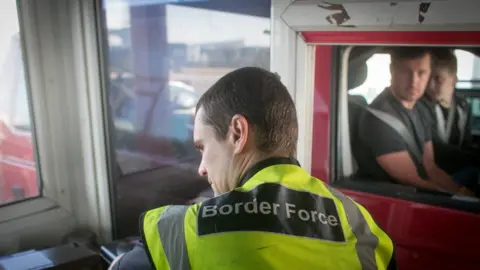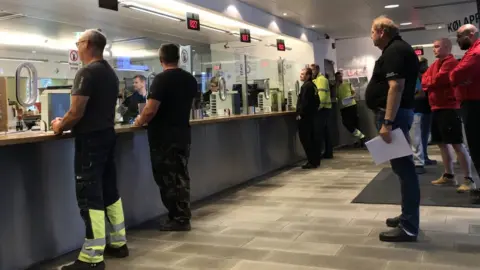Brexit backstop: Can technology solve the Irish border problem?
 Getty Images
Getty ImagesThe controversial backstop, designed to eliminate the need for a hard border in Ireland, continues to be the major sticking point in the Brexit negotiations.
Some of the MPs who have rejected Theresa May's Brexit deal say they have not been convinced by the arguments that the arrangement would only ever be temporary. They believe that alternative arrangements, such as technological solutions, would eliminate the need for a backstop in the first place.
So how viable is this?
What is the backstop?
The backstop is an "insurance policy" - designed to avoid a hard border "under all circumstances" between Northern Ireland and the Irish Republic.
Under the current Brexit deal, the 310-mile Irish border would become the only land border between the EU and the UK.
This would probably mean checks on goods crossing it, unless both sides could reach a comprehensive trade deal.
If such an agreement couldn't be reached, then to avoid those checks and border posts or other infrastructure, the backstop would come into force.
It would keep the UK in a "single customs territory" with the EU and leave Northern Ireland effectively in the EU's single market for goods.
A number of MPs fear the UK could be "trapped" in this arrangement for years, leaving it unable to strike its own trade deals on goods with the rest of the world.
Existing technology
Norway and Sweden have one of the most technologically advanced borders in the world.
Norway is not in the EU (although it is in the single market) and its 1,000-mile border with Sweden is the EU's longest land border.
Cars go through unmanned border posts equipped with cameras that use an automatic number plate recognition system.
And a sophisticated computer system allows goods to be declared to customs before they leave warehouses.
But lorries transporting goods must still stop at a staffed crossing for physical customs checks.

At the main border crossing, at Svinesund, Norwegian customs says, it processes about 1,300 lorries every day - and each one takes about 20 minutes.
Lars Karlsson, who used to be a senior Swedish customs officer, wrote a report for the European Parliament on how technology could be used at the Irish border.
He told BBC News technology alone wouldn't eliminate the need for checks at the Irish border and the success of the Sweden-Norway customs border relied on high levels of trust and similar product standards.
In any case, the border is not frictionless and there are border posts - and both of these elements would be intensely controversial on the Irish border.
The EU's deputy chief negotiator, Sabine Weyand, has already ruled out using existing technology.
"We looked at every border on this Earth, every border the EU has with a third country - there's simply no way you can do away with checks and controls," she said following the vote in the UK Parliament.
'Unique solution'?
The European Research Group (ERG), which is made up of pro-Brexit Conservatives, has outlined a "unique solution" involving a mix of technology and a simplifying of custom procedures in its report A Better Deal.
"No checks at the border" would be needed, Hans Maessen, one of report authors, told BBC News.
He said checks could be carried out at warehouses instead:
"You make a declaration and customs can say, 'Hold up, I'll come by with my car and inspect your goods,'" Mr Maessen said.
This system could be developed using existing IT systems and no physical infrastructure would be required, he added.
But the EU requires physical inspections on certain goods at the point where they enter the single market. This applies to some animal products and food products.
And the ERG's report appears to acknowledge this.
"Inspections on veterinary and SPS (sanitary and phytosanitary) regulations shall be done at the premises of the exporter, importer, or at official border inspection facilities, located in the vicinity of the point of entry into the territory of the other party," it says.
 Getty Images
Getty ImagesAnd some worry that any new checks - even ones away from the border - could create tensions.
Last year Northern Ireland's Chief Constable, George Hamilton, warned of the risks that customs officers could face.
"Whether that be HMRC [HM Revenue & Customs], whether that be people engaging in checking of standards and products, then I think it's highly foreseeable that they will become the subject of threat," he said.
Future technology
One potential, but expensive, way of avoiding physical checks altogether at the Irish border could be to develop a satellite system, according to Mr Karlsson.
"The driver could have a phone in their pocket, linked to a satellite. And when the truck passes the border, a computer would automatically register it," he said.
 Getty Images
Getty ImagesSo could a future technological solution to the backstop work?
"Theoretically, I believe it could be done," said David Henig, director of the UK Trade Policy Project think tank.
"However, it would require huge amounts of trust and money. What happens if a lorry driver doesn't register? And in any event, it certainly couldn't be delivered in the next few years."
This solution also doesn't get round the fact that EU law requires physical inspections of some products.
 Getty Images
Getty ImagesTime limiting
So what about another "alternative" - simply time limiting the backstop so that it automatically ends?
This would defeat the whole purpose of the backstop, according to Katy Hayward, an expert in border studies, at Queen's University Belfast.
"What happens when that time limit expires? Time limiting the backstop pretty much kicks the can down the road and doesn't face up to the reality of what to do about the Irish border after the transition period," she said.
A right to withdraw?
Another suggestion is for the UK to have the right to withdraw from the backstop without EU agreement - a so-called "unilateral exit mechanism".
The fear from some Brexit-supporting MPs is that the EU might drag its feet when it comes to negotiating a free trade agreement, or worse, talks could break down completely.
And this could leave the UK trapped in the backstop with no obvious way out.
If the UK just walked away and left the backstop, however, it could harm relations to the point where a future trade deal with the EU became almost impossible to achieve.
And the EU says the current backstop plan is the only "realistic solution" to preventing a hard border in Ireland.
So, at the moment it looks as if there are no easy solutions - especially one that would be acceptable to the EU, the UK government and the majority of MPs.



